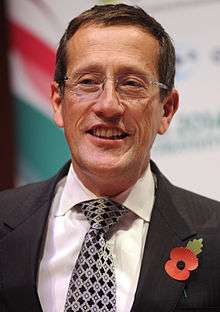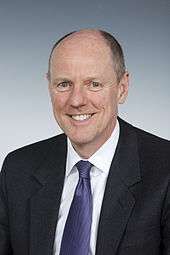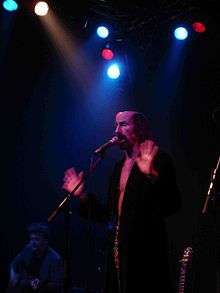Roundhay School
Roundhay School is an mixed all-through school and sixth form located in Roundhay, Leeds, West Yorkshire, England. At its last Ofsted inspection in 2013, it was judged 'outstanding', one of only three secondary schools in Leeds to hold this rating.
| Roundhay School | |
|---|---|
 | |
.jpg) Roundhay School from Old Park Road | |
| Address | |
Old Park Road , , LS8 1ND England | |
| Coordinates | 53.830640°N 1.510637°W |
| Information | |
| Type | Community school |
| Motto | Responsible, Resilient, Ready to Learn
Virtutem Petamus (old Boys’ school) Vouloir c’est pouvoir (old Girls’ school) |
| Established | 1903 1972 (merger) |
| Local authority | City of Leeds |
| Department for Education URN | 108076 Tables |
| Ofsted | Reports |
| Head Teacher | Matthew Partington |
| Staff | 120 |
| Gender | Mixed |
| Age | 4 to 18 |
| Enrolment | 2600 |
| Colour(s) | Green, Black and white |
| Website | http://www.roundhayschool.org.uk |
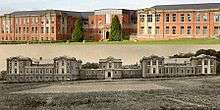
It contains about 2600 pupils, with about 500 pupils in the sixth form. The current headteacher is Matthew Partington.[1] Located directly opposite Soldiers Field in Roundhay Park, the school grounds are 22 acres (89,000 m2).
History
The embryo of what was to become Roundhay School came into being in 1903. It was set up by two former Governesses. One, a Dutch lady named Miss Johanna Gerardina Blok (1866-1940) and the other Miss Georgina Bent Shute (1862-1946) who arrived from the other side of the Pennines. The details of their meeting are still unclear, but between them they set up Lidgett Park School in a building on North Park Avenue. Initially 4 girls (Anne Lupton, Cissie Woolly, Diana Wright and Elsie Jeeves) were educated at this site but numbers grew steadily. By September 1916, 64 pupils were on roll and it was at this point that a former teacher at the school, Miss Marion Christina Vyvyan (1882-1939) was asked to return, by Miss Blok and Miss Shute, to become the new Headmistress. One of Miss Vyvyan’s first acts was to rename the school Lidgett Park High School, though the school colours and the school motto (Vouloir c’est pouvoir) were kept.
The School continued to grow under Miss Vyvyan’s leadership and in spring 1917 they took ownership of the tennis courts on Shaftesbury Avenue. Further to this, and unable to sidestep a challenge, the school absorbed a school located at 29 Shaftesbury Avenue (next to the tennis courts) from Miss Crabtree and also took on St George’s Boys’ School due to the illness of its Headmaster, Mr Davies. This meant that by September 1917 the school had 99 girls on roll (the nucleus of what is to become Roundhay High School for Girls) and a new Boys Department (based at 29 Shaftesbury Avenue) with 20 boys (the nucleus of what is to become Roundhay School). The School continued to progress over the next few years and by the end of 1918 (with 128 girls on roll) it was clear that a next decisive step was needed. To this point, the school had been dependent entirely on private enterprise but now Miss Vyvyan wanted the school to come under Local Authority control. Dr James Graham, the Director of Education for Leeds, eventually agreed and in September 1919, Lidgett Park High School became Roundhay High School for Girls and a maintained school.[6] This was followed in 1920 with the absorption of St Ronan’s school. By now the school numbers were such that new accommodation was needed. Through consultation with Dr Graham, the Gledhow Hill Estate was purchased and in September 1921 the school moved into its new building, a building that still exists at Roundhay School, known by all as ‘The Mansion’. The Mansion was separated into two sections – one for the Girls and one for the boys, though the Lidgett Park site was maintained for younger children in the form of a Preparatory department. Mr Gerald Hinchliffe (1900-1993) and Mr John Nind (1896-1926) were appointed to teach the Boys whilst Miss Vyvyan and her staff continued to educate the girls. By this point the school had a total of about 260 pupils; 155 in the Girls School, 70 in the Boys department and 35 in the preparatory department. By September 1922 this number had risen to 300 and the number of boys was also increasing. It was therefore decided that a Boys school needed to be created. With this in mind Mr Benjamin A. Farrow (1886-1951) was appointed as Headmaster, starting in January 1923. Although taking charge of Roundhay School for Boys, Mr Farrow immediately changed the name to just Roundhay School. Against much parental protest the school was temporarily moved to Potternewton mansion in order that it had the space it needed and that the Girls also had the space they needed in the Mansion. On the same day the Boys entered Potternewton Mansion, the first steps were taken in the building of the new School on the Gledhow Hill estate which stood for the next 80 years on the site of the current Roundhay School building.
By September 1925 some of the boys (Juniors) were transferred from Potternewton Mansion into the new building. The transfer was completed in January 1926 when the Seniors joined them in the new building. In total 279 boys were on roll. The new building was officially opened on 25th June 1926 by Lord Percy, President of the Board of Education. Both Roundhay School and Roundhay High School for Girls continued to grow over the next 5 years. By the late 1920s it was clear that the Girls School was going to need new accommodation. Temporary Army huts were used from 1929 but by 1931 a new, permanent building was constructed at the Thorn Lane/Jackson Avenue end of the Gledhow Hill estate. The girls moved in at the start of the 1931 academic year and the building was officially opened on November 25th 1932, by which time the Girls school had 417 on roll and the Boys school had 579.
In 1936, owing in large part to ill health, Miss Vyvyan retired as Headmistress and was replaced by Miss Hilda Nixon (1894-1980). The direction of the Girls School was maintained and numbers continued to grow. The Boys school also continued to grow and by the outbreak of war there were around 600 pupils on roll. The Boys school was evacuated in 1939 to Lincoln, though not all the boys went, whereas the Girls were evacuated only as far as Otley. In the boys case the evacuation was hugely unsuccessful and Roundhay School reopened its doors in January 1940, much to the delight of the vast majority of the Boys. Numbers continued to grow throughout the war and by 1945 Roundhay School had just under 1000 boys to educate.
It is known that at least 890 old boys of Roundhay served in the Second World War[9], in all the different divisions. Of these, 88 were killed in action, including Leeds’ only Victoria Cross from the war, Arthur Louis Aaron. One Master, William E Bridges was also killed in active service. All of the old boys who lost their lives in the war are commemorated on a Memorial Board which to this day is on the wall of the Main School Hall.
The Education Act (1944) which was enacted after the War had ended, ushered in the next chapter of Roundhay’s history. Fees were scrapped, the leaving age was raised to 15 and both boys and girls would now need to pass the 11-plus in order to get into their respective schools (Grammar Schools).
In 1949 Mr Farrow was forced into retirement by ill health, dying 2 years later in 1951. Mr GG Hall (1897-1971), one of the original teachers in the boys’ school and Second Master, became acting Headmaster for a term until Mr Ernest Howarth (1902-1962) arrived, having been Headmaster at Scunthorpe Grammar School previously. Both schools now went through a period of relative calm and stability. Miss Nixon remained Headmistress of the Girls’ School until she retired in 1958, at which point she became very active in the International Vegetarian Union (IVU) until her death in 1980. She was replaced as Headmistress by Miss M R Lee (1921-2013) who remained Headmistress of the Girls’ school until 1972. Mr Howarth, universally and sadly feared by the boys under his care, died whilst Head during the Xmas holidays in 1962. He was replaced by GG Hall until the end of the academic year, but upon his retirement Clifford Glover (1923-2015) took up the post as Headmaster.
It was during the 1960s that many stalwarts of the Boys’ school started to retire. GG Hall retired in 1963 after 40 years of service to school. This was shortly followed by Mr Hinchliffe in 1965, retiring as Deputy Headmaster having spent 44 years teaching the boys of Roundhay School. His replacement as Deputy Headmaster was Mr Doug Morris, a former Roundhay pupil, Head boy and cricket captain, who remained Deputy Headmaster until 1983 when he retired. Finally, in 1969, Mr Clifford Keightley retired after teaching Science for 43 years at Roundhay. The ending of these long, distinguished careers happened just before the next sea change in education at Roundhay.
1972-1992[8]
In 1972, the Boys’ and Girls’ schools merged to form a mixed comprehensive for 13-18 year olds (pupils no longer needed to pass the 11 plus to get into the school). The school had just under 1400 pupils with around 360 pupils in each year group. Mr Glover became the Headteacher of the combined school and Miss Lee (along with Mr Morris) became his Deputies. The merging of the two schools into one large comprehensive was not without its challenges but staff were determined for it to succeed. In 1972, Mr Ian Rothbury joined the school as a teacher of Geography, staying for the next 37 years, 23 of which he was the Deputy Headteacher. He joins the list of staff who, through longevity of service, made the many transitions in Roundhay’s history, as seamless and successful as possible. In 1977 Miss Lee retired and was replaced by Mr Terry Elliot as Deputy Headteacher. Her retirement was followed in 1980 by the retirement of Mr Glover and the appointment of Mr Kerr Mackie as Head. He brought in Mr John Urwin as Deputy, creating a school with 3 Deputies! Throughout the 1980s the school continued to improve, though there was significant disruption to teaching owing to asbestos being found in the buildings. The impact of this was that many pupils only attended school on alternate days. In 1987 both Mr Elliot and Mr Urwin left Roundhay and were replaced by Miss Jean Clennell and Mr Bryan Smith (Mr Morris had already retired in 1983). In 1990, Kerr Mackie died prematurely and Mr Rothbury took over as Headteacher temporarily.
1992-2012[8]
In 1992 schools in Leeds were once again reorganised. The Middle School system that was set up in 1972 was abolished and schools, including Roundhay, became an 11-18 comprehensive. Along with this structural change, Mr David Wilson arrived as Headteacher as his previous school had been closed as a result of the reorganisation. Moreover, as the school was now admitting year 7, 8 and 9 pupils, it needed more teachers. There was a significant change in staffing, so in September 1992 the school looked significantly different to how it had looked a year previously. In 1995 the school was judged to be Satisfactory by Ofsted and in 1996 Mr Wilson retired as Headteacher. His replacement, Mr Neil Clephan, was to remain at Roundhay for the next 20 years. By this time, the old Girls school was known as Senior School and the old Boys school was the Lower school. Teachers had to move between the two buildings to teach pupils of different ages, causing some disruption.
In 1999 Ofsted returned and rated the school as Good.
In 2003, Roundhay School as we now know it came into existence. The old Girls’ School was demolished and the Old Boys’ school was knocked down but the fascia was kept. A new school was built behind the old fascia of larger proportions. The new building was officially opened on 12th July 2004 by Sir Evelyn de Rothschild. The vast majority of teaching took place in the new building though some sixth form subjects were still taught in the mansion. In 2007 Ofsted once again returned to Roundhay and judged the school to be outstanding. Throughout the 2000s academic outcomes had gradually improved and by the start of the new decade Roundhay was in an excellent position to push on to the next level, though this would need to be without Mr Rothbury who retired in 2010 after 37 years of service.
2012-Present day[2]
In 2012 Roundhay School once again changed and became one of the country’s first ‘all through schools’. A primary campus was opened about 1 mile away from the secondary buildings and pupils were taken into reception as a 2 form entry. In November 2013 Ofsted returned to Roundhay (now an all-through school) and graded it as Outstanding in all areas. The inspection came off the back of Roundhay’s best ever GCSE results the previous summer. It was also in the previous summer that Miss Clennell retired as Deputy Headteacher after 26 years of service to the school.
In 2016, Roundhay was approached by the Local Authority to up its intake to 300 pupils per year group in order to accommodate a local population boom. As part of this agreement Roundhay got a new building, called the Pavilion, which was opened in 2017. The Pavilion is nominally the Sixth form centre but all pupils are taught there as it houses departments like History and Geography. The building of the Pavilion was Mr Clephan’s last major act and he retired at Xmas 2016 (though he stayed on to manage the building work). He was replaced in January 2017 by Mr Matthew Partington. In 2019 the primary and secondary schools finally converged and the first pupils from Roundhay primary school started secondary school.
Extracurricular activities
Roundhay School runs various extracurricular activities for pupils during the lunch period and after school. Sport, an important part of extracurricular life at Roundhay, is facilitated through playing fields and indoor sports halls. Chief sports are football, rugby union, netball, cricket and hockey – many pupils continue to play for hockey teams after leaving school. School pupils also play in tennis and athletics competitions. There is also trampolining class and a climbing wall.
There is a yearly school drama production which includes pupils of any age. Recent productions have included Sister Act, We Will Rock you and Little Shop of Horrors.
Roundhay School runs trips abroad on annual and 2 year cycles. These include art trips to New York City, Germany, and Barcelona, and also yearly language trips to Spain, Germany and France. The school also runs a skiing trip to Canada, and, in 2010, to Austria. History trips take place every year to Skipton Castle, the Imperial War Museum and World War I battlefields across France and Belgium. In 2012, the Sixth Form Geography department travelled to Iceland, taking in thermal springs and volcanoes. In 2014, the department also travelled to Morocco.
Ofsted and Outcomes
Roundhay School receives consistent highly rated Ofsted reports, and external examination results are above the national average.[11] In 2007, the school received the best A level results of all the state schools in the city of Leeds, and the second best in the district. Since 2017 Roundhay School has seen significant improvements in its Progress 8 score. In 2019 the School's Progress 8 score was +0.51, placing it in the top 11% of schools nationally for the amount of progress pupils make between Key stage 2 and key stage 4.[12]
In 2020 it received a World Class Schools Quality Mark, which requires an 'Outstanding' Ofsted assessment as well further assessments. [13]
Notable former pupils
The Roundhay School
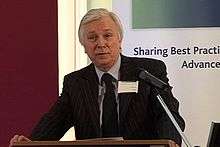
| Name | Birth | Death | Notable for | ||
|---|---|---|---|---|---|
| The Roundhay School | |||||
| Nick Gibb | 1960 | Conservative MP, Minister of State for Schools | |||
| Zodwa Nyoni | - | playwright | |||
| Richard Quest | 1962 | CNN International presenter | |||
| Elizabeth Truss | 1975 | Conservative MP, Secretary of State for International Trade, former Chief Secretary to the Treasury and Secretary of State for Justice | |||
| Roundhay Grammar School for Boys | |||||
| Arthur Louis Aaron | 1922 | 1943 | Recipient of the Victoria Cross | ||
| John Beer (priest) | 1944 | Archdeacon of Cambridge from 2004–14 | |||
| John Blackwell (ambassador) CBE | 1914 | 1986 | Ambassador from 1972–74 to Costa Rica | ||
| Sir Geoffrey Bowman | 1946 | First Parliamentary Counsel from 2002–06 | |||
| Arthur Brown | 1942 | Singer of the pop hit Fire. | |||
| Derek Evans (conciliator) CBE | 1942 | Chief Conciliator from 1992–2001 at Acas | |||
| Linal Haft | 1945 | Actor | |||
| Edouard Lapaglie | 1956 | Comedian and Radio Leeds performer | |||
| Andrew Lees | 1947 | Francis and Renee Hock Professor of Neurology since 1998 at the Institute of Neurology at UCL | |||
| Edward Lyons | 1926 | 2010 | Labour MP from 1966–74 for Bradford East and Bradford West from 1974–83 | ||
| Adrian Metcalfe | 1942 | Silver medallist in the 1964 Tokyo 4 × 400 m relay, and ITV sports commentator from 1966–87 | |||
| Jack Higgins | 1929 | Pseudonym of Harry Patterson, author of The Eagle Has Landed | |||
| Geoff Raisman | 1939 | Neuroscientist | |||
| Geoffrey Richmond | 1941 | Chairman of Bradford City | |||
| Michael Roll | 1946 | Pianist | |||
| Christopher Rowlands | 1951 | Chief Executive from 1993–97 of HTV (now ITV Wales & West) | |||
| Philip Saffman | 1931 | 2008 | Theodore von Kármán Professor of Applied Mathematics and Aeronautics from 1995–2008 at the California Institute of Technology | ||
| Michael Salmon | 1936 | Vice Chancellor from 1992–95 of Anglia Polytechnic University (Anglia Ruskin University since 2005) | |||
| Jack Shepherd | 1940 | Actor | |||
| Roy Spector | 1931 | Professor of Applied Pharmacology from 1972–89 at Guy’s Hospital Medical School | |||
| Prof Irving Taylor (professor) | 1944 | Professor of Surgery at UCL since 1993, Professor of Surgery from 1981–93 at the University of Southampton, President from 1995–8 of the British Association of Surgical Oncology and from 2006–08 of the European Society of Surgical Oncology | |||
| John Thompson (editor) CBE | Editor of the Sunday Telegraph from 1976–86 | ||||
| Jon Trickett | 1950 | Labour MP since 1996 for Hemsworth | |||
| Prof Sir Norman Stanley Williams | 1947 | Professor of Surgery and Head of Centre for Academic Surgery at Barts and The London School of Medicine and Dentistry since 1986, President of Academic and Research Surgery since 2009 | |||
| Arnold Ziff | 1927 | 2004 | Businessman and philanthropist | ||
| Dennis Shuttleworth | 1930 | Brigadier, twice capped England Scrum-Half | |||
| Roundhay High School for Girls | |||||
| Name | Birth | Death | Notable for | ||
| Joyce Gould, Baroness Gould of Potternewton | 1932 | Labour Peer | |||
| Sylvia Kay | 1936 | Actress | |||
| Barbara Kellerman | 1949 | Actress | |||
References
- "Roundhay School - Key Staff". www.roundhayschool.org.uk. Retrieved 29 January 2020.
- "Roundhay School - History". www.roundhayschool.org.uk. Retrieved 3 November 2019.
- Vyvyan, Marion (1933). Roundhay High School 1903-1932. pp. 1–36.
- Old Roundhegian Magazine in school archive
- Girls high school magazine in School archive
- Letters between Dr Graham and Miss Vyvyan in Roundhay School's archive
- Hinchliffe, Gerald (1973). Roundhay School - The first half century. Kirkstall: Frederick Duffield and sons. pp. 3–115.
- Roundhay school staff lists in school archive
- Roundhay School War memorial book in the school archives.
- Hinchliffe, Gerald. Roundhay school - the first half century. pp. 125–175.
- Roundhay School Ofsted Inspection Reports. Retrieved 12 November 2013. PDF download required
- "School performance tables".
- Wardill, Joanna (23 January 2020). "Leeds school is named among 'best in the world'". Yorkshire Evening Post. Leeds. Retrieved 24 January 2020.
.jpg)
